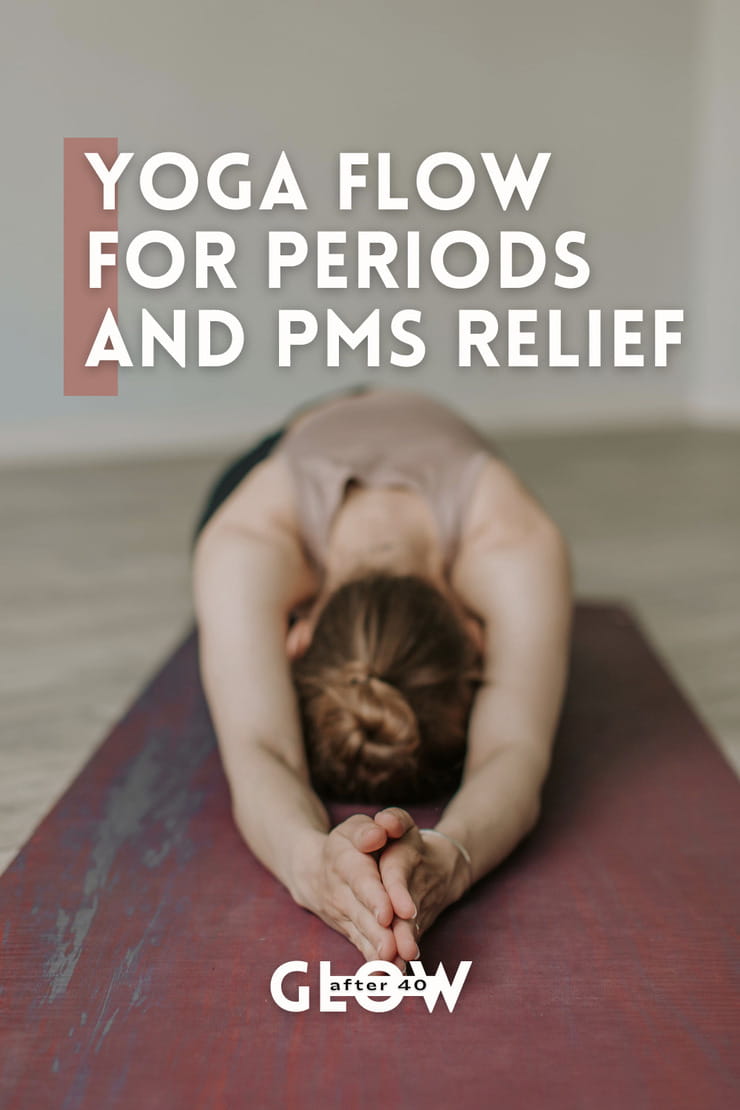How to ease PMS symptoms, relieve period pain and cramps? Can you practice yoga during your period? Which asanas can be done during menstruation?
Nature has blessed us, women, with an invaluable gift: the ability to give life! And many believe that we “pay” for this during our menstrual cycles. Especially after 40, when they can be more painful and totally unpredictable (ew, that sucks…).
But in reality, periods can be pleasant! They can! There are many natural ways to get through your period with joy and minimal discomfort. And yoga is one of our most important and first assistants.
Periods and Renewal
First of all, you must change your attitude toward these special days for women. And learn to rejoice in their coming)). Yes, the practice of gratitude in action)).
Besides the fact that thanks to menstruation we have the opportunity to conceive and bring new life into this world, there is another way to be grateful for these days.
Have you noticed that after each period we become calmer, more harmonious, more balanced? It is as if all the storms have subsided and calm has set in.
Nature is a very wise and harmonious system that has designed periods as a kind of cleansing for women: both on a physical and emotional level.
During these days our emotions are reset, negativity is shed, and after these days we feel in harmony with the whole world again. Have you noticed this?
Menstruation not only balances the flow of energy and calms us down, it also removes toxins from our bodies. It’s like a natural monthly detox.
So let’s rejoice in the monthly renewal and help ease the painful sensations with yoga.
Yoga and Periods
How does yoga help to make these days of a woman’s life as comfortable and painless as possible?
First of all, yoga (when practiced regularly) has a very beneficial effect on the entire female body, aligning the proper and coordinated functioning of all body systems (everything is very interconnected for us. For example, you cannot improve the condition of your hair without improving your digestion, etc.).
Yoga is one of the few practices that positively affects all the glands in the body that are responsible for producing the right hormones. By practicing yoga, our body begins to produce more hormones that help regulate the natural flow of menstruation:
- Periodicity is established
- Reduce back and abdominal pain
- Normalizes the volume of secretions
- Emotional balance is restored
From my own experience, I can say that yoga really helped me to make my periods not only regular, but also much less painful. Ladies who practice yoga, have you experienced the same? Share in the comments))
In addition, yoga can be especially helpful during these days, relieving pain and eliminating other unpleasant accompaniments of periods: severe mood swings, general malaise, heavy flow.
In general, if you feel bad during your period, stop suffering: get off the couch and onto the mat! Yoga will significantly improve your condition!
Basic Rules of Yoga During Periods
Yoga during your period is not only not prohibited, it is strongly recommended! You just need to follow the three basic rules of yoga during menstruation:
1. NO inverted asanas! (all asanas in which the head is below the pelvis) – to prevent accumulation and stagnation of blood in the pelvis.
Although this position is now controversial, as it has been proven that such asanas cannot lead to endometriosis, cysts and other problems.
However, from an energetic point of view, inverted asanas should not be practiced, as they disrupt the downward flow of energy during menstruation. We don’t need that, do we?
2. NO asanas with strong pressure on the abdomen, and in general – very complex asanas with general tension – this can intensify the blood flow and make the secretions more abundant and painful. In addition, menstruation is not the best time to test yourself and overdo it. However, if you have been practicing for a long time and feel like doing something more energetic, see point 3)).
3. YES to gentle asanas for relaxation and stretching, and YES to listening to your body! Most of the time, our body suggests the best option, and most of the time, it wants to do gentle, relaxing asanas. But if you feel like you want something else today – go for it!
IMPORTANT! Pay attention to your condition – if you don’t feel better and your wellbeing worsens, it means you have overdone something. Stop and rest! Be sensitive – listen to yourself!
Here is a mini-set of asanas that I like to do during my periods. It soothes and relieves pain, cramps, and other uncomfortable sensations. I hope you like it too))
Best Yoga Poses for Periods
1. Child’s Pose (Balasana)
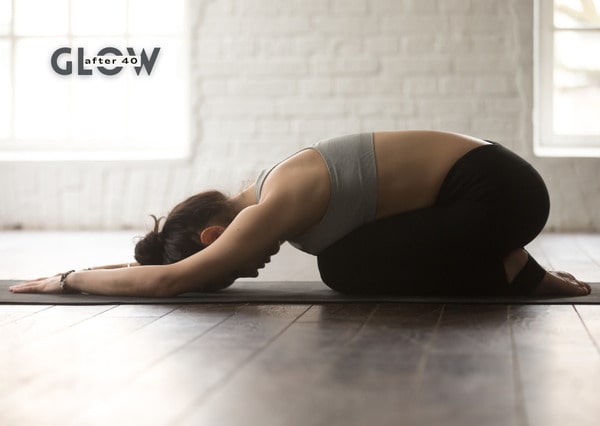
This asana is an ideal posture for relaxation. It is effective not only during intense yoga practice but also during periods and even during labor contractions (it has saved me twice already))).
Child’s Pose not only provides relief from menstrual pain but is also effective in relieving stress and emotional tension (which often occurs during our special days, right, ladies?)).
To enhance relaxation, use a firm (sufficiently large) cushion or a couple of folded blankets.
How to do:
- If using blankets or a cushion, place them along the mat. Sit at the edge of the cushion with knees touching its edge, or if more comfortable, spread the knees apart (as far as comfortable) and place the cushion between them.
- From a sitting position on your heels, slowly lower down until your forehead touches the floor (or support). You can spread your knees apart (as far as comfortable).
- Place your arms freely alongside your body with palms facing up or extend them forward. Relax your arms. If using a cushion, you can hug it, and turn your head to the side, touching the cushion with your cheek.
- Direct your tailbone towards the floor and try to lengthen the entire spine towards the head.
- Relax all muscles and stay in this comfortable position for at least a minute (or as long as you enjoy)).
- Breathe slowly and deeply, relaxing more and more with each inhalation, focusing your attention on the pelvic area.
- To exit the pose on an inhale, lifting the tailbone down, slowly rise (you can use your hands for assistance). It is important NOT to strain the pelvic and abdominal areas at this moment.
For beginners: This asana is so simple and comfortable that even beginners can easily do it. If your forehead doesn’t reach the floor, you can simply place a prop under your forehead.
Yogi Tip: Try to imagine how each inhale literally fills you from the inside with warm and bright energy, stretching the entire spine. And as you exhale, all pain and negativity dissipate.
2. Seated Forward Bend (Paschimottanasana)
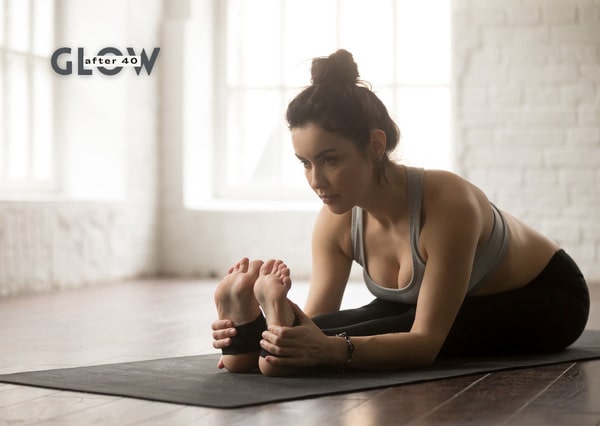
This seemingly simple asana is very beneficial for women’s health in general and especially during these special days:
- Eliminates unpleasant symptoms of menstruation and menopause.
- Normalizes the functioning of the endocrine system.
- Helps overcome infertility and increases the chances of conception.
- Decreases appetite and improves digestive processes.
- Tones the muscles of the buttocks and thighs and removes excess fat from the abdomen.
- Improves posture and eliminates spinal curvature.
- Calms the brain and nervous system, relieving depression.
You can use a firm large cushion or folded 2-3 blankets (whichever is more comfortable for you). A chair might even be useful—try different options and choose what you like best.
How to do:
- Sit on the floor with a straight back, legs extended forward. If using a chair, place it over your knees and ankles, and put the cushion on the chair or directly on your legs.
- Point the toes towards yourself.
- Lean forward slightly and lift the buttocks up and outward (you can even help with your hands) to bring the perineum as close to the floor as possible.
- On an inhale, raise your arms up and stretch your sides and spine upwards.
- On an exhale, slowly lower the torso down, gradually laying the spine from the tailbone to the crown of the head. Focus NOT on lowering below but on lengthening the spine as much as possible.
- Lower the forehead to the knees (or the cushion or chair). Do not round your back! If the head does not touch the knees, do not force it!
- Place your hands in a lock behind your feet (or on the cushion or chair). Relax your hands. Do not try to lower the torso further by using the strength of your hands—this can lead to a lower back injury.
- Shoulders are relaxed and do not reach towards the ears.
- Stay in the pose for 5-7 breaths.
- Breathe slowly and deeply, with each inhale, relaxing more and directing attention to the pelvic area.
- To exit the pose, slowly (vertebra by vertebra, starting from the lower back and moving up to the head) lift the torso up. It is important NOT to strain the pelvic and abdominal areas at this moment.
For beginners: If you cannot lower the torso to the legs, simply straighten the spine forward and upward and focus on elongating the spine in this direction.
Yogi Tip: Actively work with your legs (they are tense and stretched), which will allow you to go into a deeper bend. On the other hand, relax your arms and shoulders.
3. Camel Pose (Ustrasana)
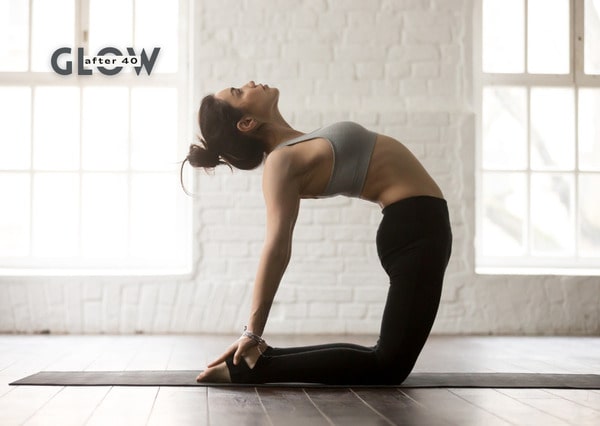
This asana not only relieves many menstrual symptoms such as back pain, abdominal cramps, fatigue and restlessness, but also actively affects the entire body.
Camel Pose is one of the asanas that powerfully tones the entire body and provides a lot of energy.
Ustrasana strengthens the entire body: shoulders, back, chest, arms, abdomen and thighs. It also makes the spine flexible and the posture straight and beautiful.
Camel Pose helps normalize the hormonal system by improving the functioning of the thyroid and reproductive glands. It also improves circulation and purifies the blood.
How to do:
- Kneel on the floor with knees hip-width apart, hands freely resting down along the thighs.
- Inhale, lift the crown of the head upward, as if stretching the sides upward and lean backward, placing the palms on the heels (or under the sacrum, supporting it).
- Exhale, arch the chest, tilting the head backward.
- Keep the torso supported by the maximum tension in the legs, especially in the buttocks and thighs. Do NOT rely on the hands!
- Do not throw back the head; simply stretch it backward.
- Do not arch the lower back; instead, try to extend the entire spine, opening the chest and pulling the abdomen in.
- Stay in the pose for 5-7 breaths, on an exhale, tilt the torso to the right leg, lower the hands, and place the left foot on the toes.
- On an exhale, lift the left knee and return to Downward Dog.
- Repeat on the other side.
For beginners: You can place the soles of the feet on the toes to increase the level of support for the hands, or place the hands on the sacrum.
Yogi Tip: Do not squeeze the neck or pull the shoulders toward the ears. Arch the torso toward the buttocks, not the toes. Remember – the entire pose is held by the strength of the legs. You can deepen the asana by reaching inside the ankles with your hands.
4. Head-to-Knee Pose (Janu Sirsasana)
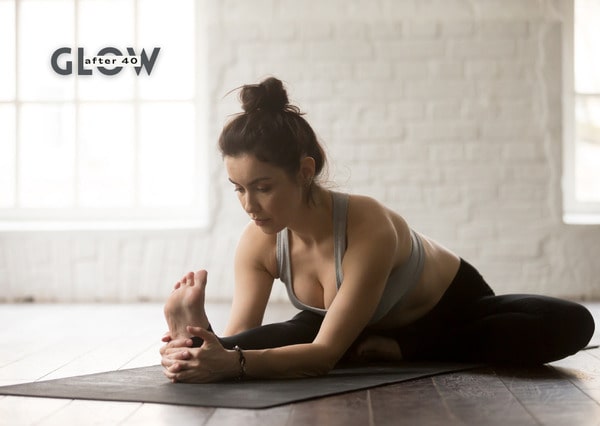
This is an excellent calming pose with the added benefit of reducing anxiety and irritability (who doesn’t have that during their period?).
This pose, like all simple forward bends, not only normalizes discharges, but also provides rest to the brain and calms the nervous system (thanks to the head support).
Again, you can use your pillows and blankets (if it is more comfortable for you). A chair may even be useful – try different options and choose what you like best.
If you feel discomfort in your knee tendons, you can place a folded blanket under your knees, but do not raise your hips too much)).
Note: If you’re having heavy bleeding, it’s better to avoid this pose.
How to do:
- Sit on the floor with a straight back, legs extended forward. If using a chair, place it over your knees and ankles, and put the cushion on the chair or directly on your legs.
- Lean forward slightly and lift the buttocks up and outward (you can even help with your hands) to bring the perineum as close to the floor as possible.
- Bend the left leg at the knee and bring the sole of the bent leg’s foot to the perineum. The sole of the left foot should press against the right thigh, and the heel should be a few centimeters from the perineum. The toes of the extended (right) leg are directed towards you.
- Lean the torso slightly to the left and turn the torso towards the right leg, lifting the buttocks a bit more and bringing the perineum even closer to the floor.
- If you are using a cushion, place it on the ankle of the extended leg now.
- On an inhale, raise your arms up and stretch your sides and spine upwards.
- On an exhale, slowly lower the torso down, continuing to stretch the spine. Focus NOT on lowering below but on lengthening the spine as much as possible.
- Lower the forehead to the knee of the extended leg (or the cushion or chair). Do not round your back! If the head does not touch the knee, do not force it! If you feel a stretch under the knee and the back of the straight leg, you can bend it and place a cushion under it.
- Ensure that the back does not twist to one side; shoulders should be parallel to the floor (not leaning towards the extended leg).
- Place your hands in a lock behind the foot of the extended leg (or on the cushion or chair).
- Relax the muscles of the back, arms, and shoulders, and stay in the pose for 5-7 breaths.
- Breathe slowly and deeply, with each inhale, relaxing more and directing attention to the pelvic area.
- To exit the pose, slowly (you can use your hands) lift the torso. It is important NOT to strain the pelvic and abdominal areas at this moment.
- Repeat on the other side (lean towards the other leg).
For beginners: If the knee of the bent leg does not touch the floor, you can place blankets under the hips.
If you cannot lower your torso down to your legs, simply straighten your spine forward and upward and focus on lengthening the spine in that direction.
Yogi Tip: Try to actively work with your legs (as if pushing off the support), which will allow you to go into a deeper bend.
The knee of the bent leg should ideally be pressed against the floor. The abdomen and chest should rest on the thigh of the outstretched leg.
Make sure your back does not twist to one side; your shoulders should be parallel to the floor (not leaning toward the outstretched leg).
5. Fish Pose (Matsyasana)
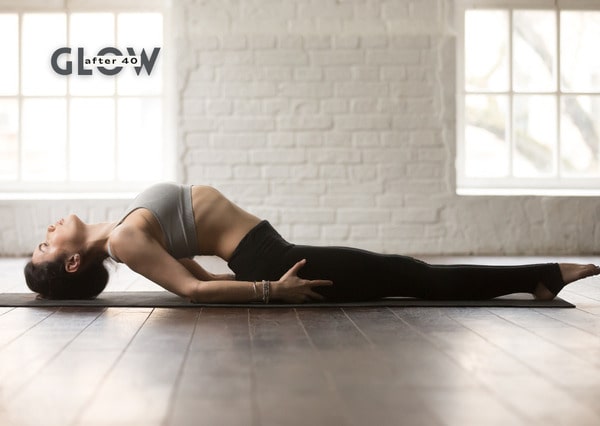
This pose is perfect for these special days because it effectively relieves fatigue, menstrual cramps, anxiety, and more.
But the most important aspect of this pose is that it gives us, women, a natural glow because it
- Stimulates the function of the endocrine system, thereby strengthening the immune system (CAUTION: if the thyroid gland is hyperactive, it’s not advisable to do this asana!)
- Normalizes the functioning of the reproductive system (i.e. promotes pregnancy)
- Heals the blood vessels of the brain, improving attention and memory
- Fills the body with vitality and rejuvenates it (but regularity is of course required))
It also stretches the muscles of the back, neck, chest, and legs, providing immediate relief from muscle aches and pains associated with menstruation.
This pose helps to stimulate the organs of the abdominal cavity, thus helping to combat dyspepsia, gas, constipation, and that uncomfortable feeling of bloating in the abdomen that often occurs during menstruation (for me, this is one of the most uncomfortable symptoms-what about you? please write in the comments)).
In the full version, this asana is done from the lotus position, but I suggest a simpler option – with straight legs.
How to do:
- If you are using blankets (or a pillow), place them across the mat. Sit on the mat with your legs extended forward (the pillow should be about 10-15 cm from the coccyx).
- Inhale slowly, arching your back and leaning on your elbows, begin to tilt your torso backward. Lift your chest, tilt your head, and place the crown on the floor (you can slightly move the elbows to find a comfortable position). Adjust the position of the head to make the maximum possible arch in the spine. If you are using a pillow, it should be under the chest.
- When the head is in a stable position, you can move your hands: either straight above your head, or place your palms down under your buttocks, or on your thighs, or just let them lie on the floor (in this case, try to bring the elbows as close to each other as possible).
- Relax your whole body. Support should be on the head, buttocks, and legs.
- Stay in this pose for 2-3 breaths (over time, you can gradually increase the duration of this asana to 5 minutes).
- Breathe slowly and deeply, with each inhale, relaxing more and directing attention to the pelvic area.
- To exit the pose, lean on your elbows and, on an exhale, slowly raise the torso into a sitting position.
For beginners: The suggested variation above is suitable for beginners as well.
Yogi tip: Make sure your mouth is closed.
6. Reclining Butterfly Pose (Supta Baddha Konasana)
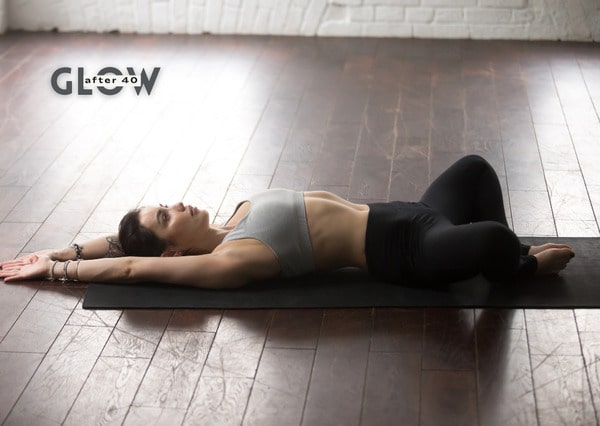
This pose has a great calming effect in general, especially during menstruation.
To make it even more relaxing, I suggest placing a firm pillow or folded blankets along the back. This will reduce pressure on the pelvic area and therefore the uterus, and help to relieve cramps and pain.
How to do:
- If you are using blankets or a pillow, place them along the mat. Sit at the edge of the pillow so that the coccyx touches its edge.
- Bring the bent legs to the perineum and join the soles together. Spread the legs and knees to the sides and gently lower them (as far as the stretch allows).
- Slowly (you can lean on your elbows) lie on your back. Try not to tense the groin and abdomen during this time. If you are using support, the spine and head should be on the blanket (or pillow), and the pelvis should be on the mat.
- Place your hands freely along the mat and relax them.
- Relax the muscles of the buttocks, groin, and abdomen and stay in this comfortable position for a minimum of one minute (you can even go for 5, or as much as you enjoy)).
- Breathe slowly and deeply, with each inhale, relaxing more and directing attention to the pelvic area.
- To exit the pose, first join your knees together, and then gently, using your hands, lift yourself from a lying position. It is important NOT to strain the groin and abdomen at this moment.
For beginners: If it’s difficult to keep the soles of your feet close to the perineum, lie against the wall so that the soles of your feet touch the wall. If your groin is uncomfortable, place blankets under your hips.
Yogi Tip: Try not to arch your lower back too much, especially if you are not using a support. For a greater stretch, you can raise your hands above your head.
Our female body is an amazingly beautiful and wonderful creation that can create life, so it’s worth giving it a little more love and attention. Especially in these feminine days))
And the time spent in these simple asanas is absolutely worth it to give our bodies a chance to rest and recover. Spend this time with benefit and joy, and get to know yourself even better and deeper.
I would like to hear how this restorative practice has helped you during your period. Have you felt any physical or emotional relief? Did it get a lot easier? Please share your impressions in the comments.
This article and any information it contains is not a medical consultation and is not intended to treat or diagnose. Please consult your physician for any health related issues.
Wishing you happiness and health!
Sofi
